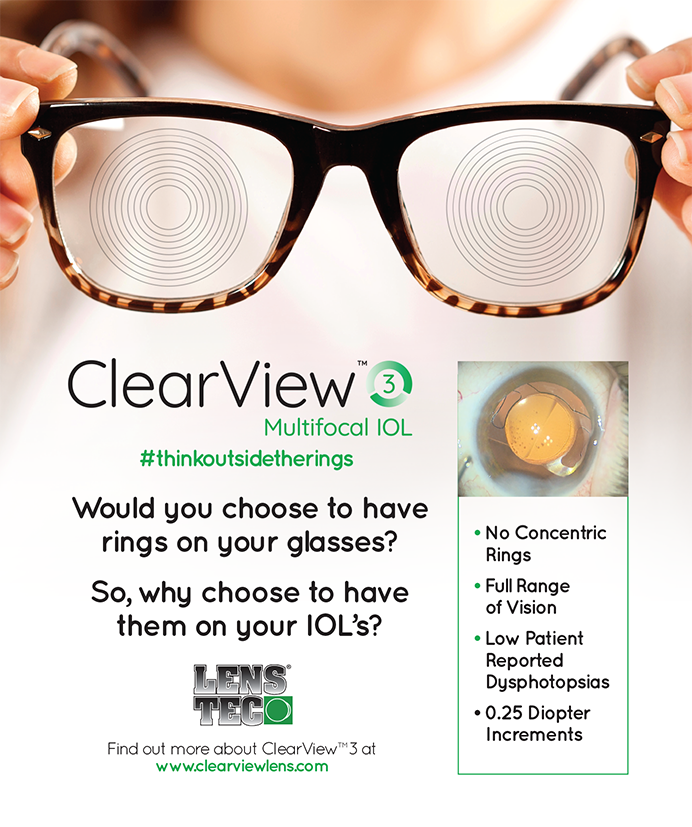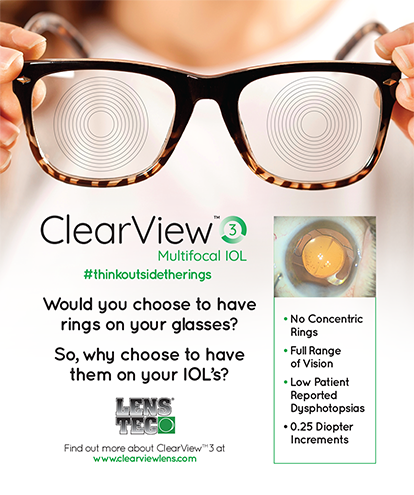In this month's edition of Cataract & Refractive Surgery Today, the cover series' overarching topic—mixing presbyopia-correcting IOLs—highlights ophthalmologists' growing realization that we do not yet have an off-the-shelf, comprehensive presbyopia-correcting IOL. No lens delivers all ranges of vision. Typically, the AcrySof Restor IOL (Alcon Laboratories, Inc., Fort Worth, TX) misses intermediate vision, whereas the ReZoom IOL (Advanced Medical Optics, Inc., Santa Ana, CA) and the Crystalens accommodating IOL (Eyeonics, Inc., Aliso Viejo, CA) fail fully to deliver focus at near.
Mixing IOL technologies between contralateral eyes represents ophthalmologists' attempt to mitigate the effects of these fixed reading-zone deficiencies by pairing lenses that complement one another. I believe that this approach is effective in that regard. These strategic IOL combinations also have solid support in the current theories of the neurophysiology of binocular vision.1-8
PHYSIOLOGIC BINOCULAR RIVALRY
Strategically pairing IOLs with different reading capabilities is an effective strategy, because the patient instantly puts the one with better focus for the task at hand to use, while images from the ineffectual lens are readily suppressed and remain unnoticed. The moment the task changes (eg, from computer work to reading the stock charts), the brain shifts to focusing through the other lens. This continual interocular contest for visual awareness is binocular rivalry at work.
Along with fusion and stereopsis, rivalry is a regular aspect of physiologic binocular vision. Binocular vision employs a neural circuitry that evolved to mediate interocular differences. Primates are hardwired to make effective use of just the sort of differences that these IOL pairings present.
PSEUDOPHAKIC MONOVISION
Pseudophakic monovision means mixing conventional IOLs with different focal lengths, each with just the right amount of myopic focus. The resulting anisometropic rivalry becomes the vehicle to ride these neural rails and deliver a made-to-order range of uncorrected focus selected to best meet each patient's particular goals.
A candidate's unique anisometropic "sweet spot" is unambiguously revealed by preoperative assessments, including interocular defocus tolerance, suppression capacity, targeting, and oculomotor dominance. The most important test measures sensory dominance separately for near and distance vision. In my experience, with sensory dominance correctly identified, the vast majority of patients instantly and effortlessly accept 2.00 D or more of anisometropia. Usually, however, no more than 1.50 to 1.75 D of anisometropia is needed because of the additional 1.00 D of accommodative effect derived from pseudoaccommodation—a very useful property of every conventional IOL. Thus, neuroadaptation is not experienced by patients with authentic pseudophakic monovision, who typically report that their results feel "completely natural" within 1 to 2 days. That may not be the case with multifocal patients, as discussed in the next section of this article.
NEUROADAPTATION: THE FOREMOST CONCERN WITH MULTIFOCALITY
Combining complementary multifocal IOLs can effectively address the particular focus-zone deficiency inherent in each lens. This mixture does nothing, however, to address the prolonged neuroadaptive period these lenses typically require.
The concept of multifocality is fundamentally at odds with current theories of the neurophysiology of binocular vision. Again, the structure and function of the visual cortex evolved to mediate interocular image disparity. Multifocality's intraocular disparity has no physiologic precedent. Without a neural template to separate out and convey the needed focus into awareness, a prolonged neuroadaptive period is required to put in place the necessary neural tracks. As the brain adapts, the "smeared" vision emblematic of truncated focal distinction slowly moderates and often, but not always, gradually disappears. It is a testament to the astonishing plasticity of the visual cortex that neuroadaptation occurs at all, let alone within 6 to 12 months. When adaptation falls short and the patient loses faith, bilateral explantation is sometimes the only answer, regardless of a technically perfect procedure. Clearly, ophthalmologists must identify and exclude those patients who are less likely to neuroadapt. The question is how.
MISCONCEPTIONS OF MONOVISION
A large part of the conventional wisdom concerning pseudophakic monovision is either incomplete or simply incorrect. Here are some key misconceptions.
- Pseudophakic monovision is like permanent contact lens monovision. Despite the paucity of preoperative assessments with and problems related to the contact lenses themselves, contact lens monovision has a relatively high acceptance rate among patients (65 by my estimate). Authentic (surgical) pseudophakic monovision, which includes a comprehensive preoperative assessment, has an acceptance rate of greater than 95 among those of my cataract surgery patients who select presbyopic correction. The difference is due to the larger anisometropic "sweet spot" that results from pseudophakic pseudoaccommodation.
- Surgeons cannot charge for pseudophakic monovision. Because this approach uses a conventional IOL, there is no uncovered device charge. The charges for the surgeon's services in conjunction with presbyopic correction are for appropriate refractive assessments and procedures. These are uncovered and apply regardless of the IOL employed.
- Pseudophakic monovision creates troublesome visual compromise. Part of a recent letter to me from a colleague is perhaps the best response here (Figure 1). I was struck by what his account of his experience with pseudophakic monovision did not include: (1) any period of neuroadaptation; (2) any compromise in stereopsis, depth perception, contrast sensitivity, reading of fine print, or intermediate focus; and (3) any need for exercises to strengthen his accommodative ability.
THE RIGHT QUESTION
Pseudophakic monovision is perhaps the most versatile approach to presbyopic correction, because the accommodative effect is not fixed but rather entirely created by the amount of anisometropia. Furthermore, combining multifocal IOLs introduces an important new degree of versatility to the premium IOL category. A comprehensive treatment methodology requires that ophthalmologists shift from a single IOL-centric approach to asking the right question: "Which combination of IOLs is best for this patient?" Surgeons should be fully familiar with each alternative in order to select the one best able to deliver the candidate's unique reading goals.
William F. Maloney, MD, is Director of the Maloney Eye Center in Vista, California, and is Associate Clinical Professor for the Department of Ophthalmology at the University of California, Irvine. He acknowledged no financial interest in the products or companies mentioned herein. Dr. Maloney may be reached at maloneyeye@yahoo.com.


